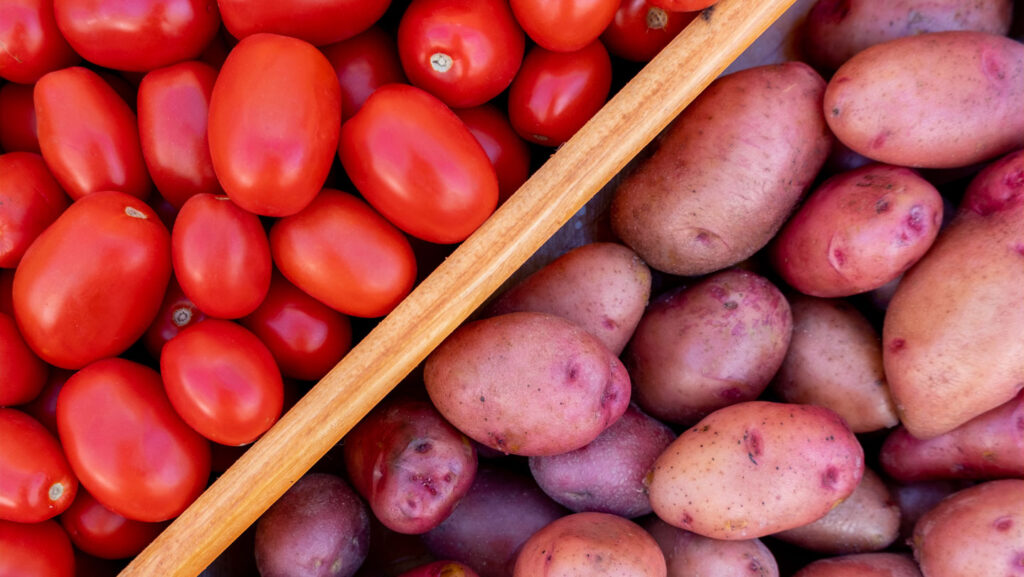The potato came from a surprising mashup.
Spuds are a basic, delicious food for millions worldwide, yet their origin and evolution have long been a scientific mystery. Not anymore, scientists say.
The starchy vegetable emerged 9 million years ago in the forming Andes mountains — a result of natural interbreeding between an ancient tomato plant and potato-like species that lacked the engorged stem bits we call tubers. This ancient cross gave rise to tubers, which were inherited across the entire potato lineage, including its 180 wild species and the thousands of cultivated varieties, researchers report July 31 in Cell.
The cultivated potato, Solanum tuberosum, is one of the world’s most important staple crops. Scientists knew potatoes were related to a small family of South American tuberless plants called Solanum etuberosum, which physically resemble potato plants but can’t form tubers. Genetics show that potatoes are also closely related to tomatoes. But scientists thought the species were like distant cousins, sharing a common ancestor with the potato. All three belong to the large Solanaceae family, which includes common farm plants such as peppers, eggplants and tobacco. Instead, these two species interbred, giving rise to the potato lineage, the scientists found.
To peel away the mystery of the potato’s origin, the researchers analyzed the genomes of dozens of cultivated potato varieties and their wild relatives. Every potato species possesses a mixed genetic composition, with approximately half of its genetic information from the tomato lineage and half from the tuberless potato lineage, the team found. This consistent signature suggests potatoes originated as a single hybrid crossing between these two groups, says Sandra Knapp, a botanist at the Natural History Museum in London.
“In creating that hybrid offspring, various gene families came together and interacted to enable the creation of tubers,” Knapp says.
A gene called SP6A, known from previous studies as a master switch for tuber initiation, came from the tomato side. Another gene called IT1, essential for the growth of the underground stems that form tubers, came from the S. etuberosum lineage. Experiments confirmed that without the IT1 gene, tubers were extremely small and without the SP6A gene, no tubers formed at all.
“How the conjunction of these genes led to potatoes making potatoes isn’t fully explained in this paper,” says plant biologist Salomé Prat at the Centre for Research in Agricultural Genomics in Barcelona, who was not involved in the new work. Just showing that these genes were inherited after the hybridization might not be enough to show that tubers appeared right away, she says. “The story is much more complicated.”
Even so, the capacity to form new, complex organs after hybridization shows that hybrid speciation is a powerful driver for evolution. New hybrids are often sterile due to genetic incompatibilities. But the tubers, which store water and nutrients, can sprout new plants from the ground if left buried, no pollination or seeds needed. That can buy the time needed to re-evolve sexual reproduction. Those traits may have given the potatoes an edge as the Andes began to emerge some 6 million to 10 million years ago.
The opening of new Andean habitats could have led to an explosive diversification of the potato, which has a wider ecological tolerance than either its tomato or S. etuberosum ancestors. While tomatoes prefer dry, warm conditions and S. etuberosum thrives in cold, wet environments, potatoes inherited a combination of traits that allowed them to flourish in cold, dry areas, effectively getting “the best of both worlds,” Knapp says.
Most of the 180 wild potato species that emerged are inedible due to bitterness or toxicity. But around 20,000 years ago, the Indigenous inhabitants of the Andes discovered a tasty, wild potato species and derived a large number of varieties from it. Spanish explorers later brought several of these varieties to Europe, leading to the potato’s global spread as a staple food.
More recent human selection for traits like high yield or pathogen resistance has inadvertently narrowed cultivated potatoes’ genetic variability, reducing their adaptability and making them vulnerable to extreme heat, flooding and other environmental factors.
Identifying the ancestral genomic contributions from tomato and S. etuberosum opens new avenues to make the potato more resilient. Scientists can now seek lost beneficial traits and reintroduce them through traditional breeding or genetic engineering, building more robust and adaptable potato varieties, Knapp says.
Read the full article here


